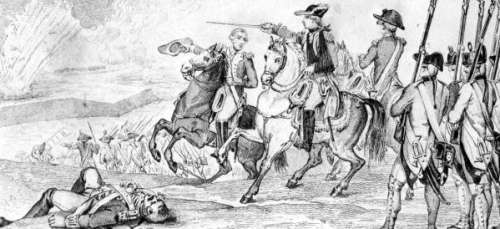 |
Patriot Resource Index
 American Revolution Index
American Revolution Index
 Surveys and Lists
Surveys and Lists
Military Campaigns:
-:Saratoga Campaign
-:Southern Campaign
-:West Florida Campaign:
Part I
Part II
Part III
-:Yorktown Campaign
Reference Lists
Surveys By Year
 American Revolution Index
American Revolution Index
 Battles
Battles
 Documents
Documents
 Events
Events
 Landmarks & Places
Landmarks & Places
 People: The Patriots
People: The Patriots
 People: Continental Army
People: Continental Army
 People: British Army
People: British Army
 Timelines
Timelines
 Books
Books
 Multimedia
Multimedia
 Links & Other Resources
Links & Other Resources
Search the Site
Site Map
Contact Us
PatriotResource.com:
Main Index
Film Index
Film: Gladiator
Film: National Treasure
Film: The Patriot
Film: Tombstone
Films: General
Films: Fantasy
Films: SciFi
History: 1775-1781
History: September 11th
Lord of the Rings
NORAM Road Trips
OtherWorld: Index
TV Series: Index
TV: Battlestar Galactica
TV: Caprica
TV: Deadliest Catch
TV: Lost
TV Series: Action
TV Series: Animated
TV: BBC Presentations
TV Series: Comedy
TV Series: Drama
TV: Fantasy/SciFi
TV Series: Western
TV Series: Reviews
Military Campaigns:
-:Saratoga Campaign
-:Southern Campaign
-:West Florida Campaign:
Part I
Part II
Part III
-:Yorktown Campaign
Reference Lists
Surveys By Year
Site Map
Contact Us
Main Index
Film Index
Film: Gladiator
Film: National Treasure
Film: The Patriot
Film: Tombstone
Films: General
Films: Fantasy
Films: SciFi
History: 1775-1781
History: September 11th
Lord of the Rings
NORAM Road Trips
OtherWorld: Index
TV Series: Index
TV: Battlestar Galactica
TV: Caprica
TV: Deadliest Catch
TV: Lost
TV Series: Action
TV Series: Animated
TV: BBC Presentations
TV Series: Comedy
TV Series: Drama
TV: Fantasy/SciFi
TV Series: Western
TV Series: Reviews

The Spanish support of the Americans in West Florida against the British was led by Don Bernardo de Gálvez, the Spanish governor of Louisiana. De Gálvez became acting governor of Louisiana on January 1, 1777, replacing Luis de Unzaga de Amézaga. He was appointed to the post by his uncle José de Gálvez, who was the Spanish minister to the Indies. Soon after taking office, de Gálvez offered his services to the American cause to Oliver Pollock, acting American agent in New Orleans.
Oliver Pollock had first come America from Ireland in 1760, landing in Philadelphia. He became a merchant in 1762, basing his operations in Havana. While there, Pollock became a friend of Alejandro O'Reilly, who in 1769 would become governor of Louisiana. In 1768, Pollock moved his operation to New Orleans. When the Revolutionary War began, he had decided to aid the American cause and had enlisted the reluctant help of Governor Unzaga in 1776 in his efforts to acquire supplies for the colonists.
For the next two years, Pollock coordinated efforts between Gálvez and George Rogers Clark to keep the American cause armed and supplied through smuggled supplies up the Mississippi River. During this time, Gálvez kept up the appearance of neutrality to the British by making occasional showy prearranged arrests of American smugglers, but he raised British ire by seizing British ships that were engaged in similar smuggling activities. Neutrality fell away when Spain declared war on England on June 21, 1779, and entered into a treaty with France. Gálvez had already begun making preparations for war before the formal declaration was made. Even after he received official word almost two months later, he made no formal announcement. Instead, he described his preparations as being purely defensive.
The first objective was to gain complete control of the Mississippi River, but before Gálvez could launch his offensive, a hurricane struck New Orleans, scattering several of his ships and leaving the city vulnerable to British attack. He took some time to reorganize his defenses and finally on August 27, 1779, Gálvez set out on foot for Fort Manchac with a company of 667 men, while a handful of ships moved up the Mississippi River. Gálvez was joined on his campaign by Oliver Pollock, who was now an official agent of Virginia and the Continental Congress. Pollock served as his aid. Only when Gálvez was in sight of Manchac on September 6, did he inform his men of the declaration of war. The next day , he launched a surprise attack on Fort Bute which met little resistance, because the British had grown suspicious of Gálvez' activities and already withdrawn their main force to Baton Rouge.
Gálvez immediately moved north to Baton Rouge. He spent several days reconnoitering and planning an attack on the well-fortified British position. Finally, on the night of September 20, Gálvez erected a battery and began exchanging artillery with the British. It was a diversionary tactic, while Gálvez had his men erecting another battery within range of the fort. The British were so preoccupied with the other battery, that they never noticed and so it was built quickly and without the men coming under fire. The next day on September 21, 1779, Gálvez attacked and captured Baton Rouge. As a provision of surrender, Fort Panmure at Natchez had to be included. Fort Panmure was peacefully surrendered to Spanish Captain Juan Delavillebeuvre on October 5, 1779, by the stunned British commander, who had no prior warning before the Spanish captain's arrival. Now that the Mississippi River had been secured, Gálvez could turn his attentions to Mobile and Pensacola, which was his true goal.
Available at Amazon.com:

Bernardo de Galvez in Louisiana, 1776-1783
by John Caughey
